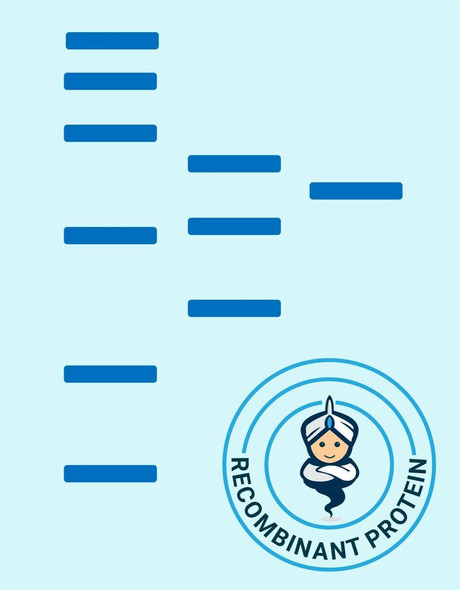Description
| Product Name: | Human Galectin-1/LGALS1 Recombinant Protein (His tag) |
| Product Code: | RPES5496 |
| Size: | 20µg |
| Species: | Human |
| Expression Host: | E.coli |
| Synonyms: | Galectin-1, Gal-1, 14 kDa Laminin-Binding Protein, HLBP14, 14 kDa Lectin, Beta-Galactoside-Binding Lectin L-14-I, Galaptin, HBL, HPL, Lactose-Binding Lectin 1, Lectin Galactoside-Binding Soluble 1, Putative MAPK-Activating Protein PM12, S-Lac Lectin 1, LG |
| Mol Mass: | 14.63 kDa |
| AP Mol Mass: | 15 kDa |
| Tag: | N-10His |
| Purity: | > 95 % as determined by reducing SDS-PAGE. |
| Endotoxin Level: | Please contact us for more information. |
| Bio Activity: | Testing in progress |
| Sequence: | Met 1-Asp 135 |
| Accession: | P09382 |
| Storage: | Generally, lyophilized proteins are stable for up to 12 months when stored at -20 to -80°C. Reconstituted protein solution can be stored at 4-8°C for 2-7 days. Aliquots of reconstituted samples are stable at < -20°C for 3 months. |
| Shipping: | This product is provided as lyophilized powder which is shipped with ice packs. |
| Formulation: | Lyophilized from sterile PBS, pH 7.4. Normally 5 % - 8 % trehalose, mannitol and 0.01% Tween80 are added as protectants before lyophilization. Please refer to the specific buffer information in the printed manual. |
| Reconstitution: | Please refer to the printed manual for detailed information. |
| Background: | Galectin-1 (Gal-1, GAL1), is a member of the galectins, a family of animal lectins ranging from Caenorhabditis elegans to humans, which is defined by their affinity for beta-galactosides and by significant sequence similarity in the carbohydrate-binding site. It is a homodimer with a subunit molecular mass of 14.5 kDa, which contains six cysteine residues per subunit. The cysteine residues should be in a free state in order to maintain a molecular structure that is capable of showing lectin activity. This endogenous lectin widely expressed at sites of inflammation and tumour growth, has been postulated as an attractive immunosuppressive agent to restore immune cell tolerance and homeostasis in autoimmune and inflammatory settings. On the other hand, galectin-1 contributes to different steps of tumour progression including cell adhesion, migration and tumour-immune escape, suggesting that blockade of galectin-1 might result in therapeutic benefits in cancer. Several potential glycoprotein ligands for galectin-1 have been identified, including lysosome-associated membrane glycoproteins and fibronectin, laminin, as well as T-cell glycoproteins CD43 and CD45. Evidence points to Gal-1 and its ligands as one of the master regulators of such immune responses as T-cell homeostasis and survival, T-cell immune disorders, inflammation and allergies as well as host-pathogen interactions. |






